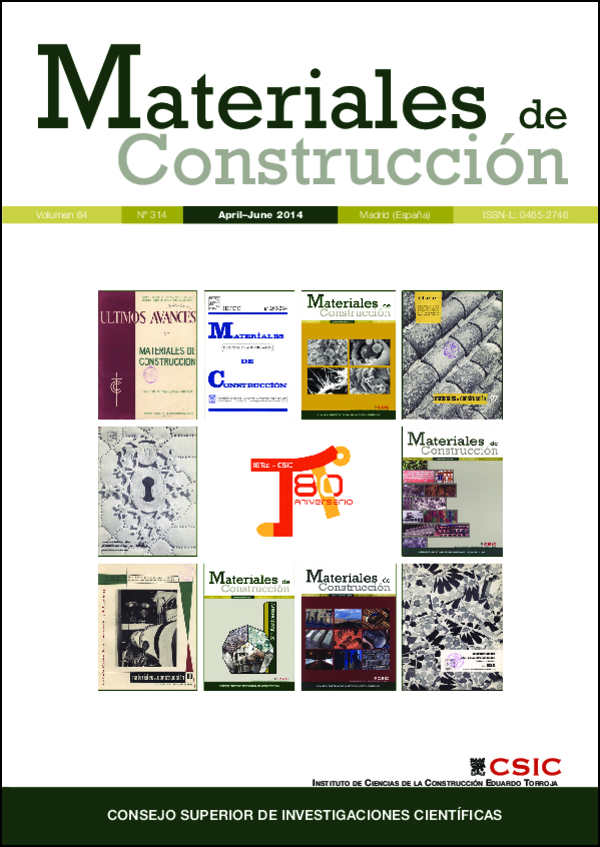Fire-resistance, physical, and mechanical characterization of particleboard containing Oceanic Posidonia waste
DOI:
https://doi.org/10.3989/mc.2014.01413Keywords:
Oceanic Posidonia waste, Particleboard, Cement, Physical and mechanical properties, fire resistanceAbstract
In this work, particleboards manufactured with Oceanic Posidonia waste and bonded with cement are investigated. The particleboards are made with 3/1.5/0.5 parts of cement per part of Posidonia waste. The physical properties of bulk density, swelling, surface absorption, and dimensional changes due to relative humidity as well as the mechanical properties of modulus of elasticity, bending strength, surface soundness, perpendicular tensile strength and impact resistance are studied. In terms of the above properties, the best results were obtained for particleboards with high cement content and when the waste “leaves” are treated (crushed) before board fabrication, due to internal changes to the board structure under these conditions. Based on the results of fire tests, the particleboard is non-flammable without any fire-resistant treatment.
Downloads
References
García-Andreu, C.; Saval Pérez, J.M.; Frías Rojas, M.; Chinchón Yepes, S. (2008) Caracterización de las cenizas de Posidonia Oceánica para su utilización como material de construcción, Ingeniería Civil, 149, 131–141.
García-Andreu, C.; Saval Pérez, J.M.; Chinchón Yepes, S. (2008) Análisis de las propiedades físicas y mecánicas de morteros de cemento con adición de cenizas de Posidonia Oceánica, Ingeniería Civil, 150, 89–102.
Organización de las Naciones Unidas para la agricultura y alimentación. (2011) Situación de los bosques del mundo Roma. http://www.fao.org/docrep/013/i2000s/i2000s00.htm
Guntekin, E.; Uner, B.; Sahin, T.T.; Karakus, B. (2008) Pepper stalks (Capsicum annuum) as a raw material for particleboard manufacturing, Journal of Applied Sciences, 8 [12], 2333–2336. http://dx.doi.org/10.3923/jas.2008.2333.2336
Betkas, I.; Guler, C.; Kalaycioglu, H.; Mengeloglu, F.; Nacar, M. (2005) The Manufacture of Particleboards using Sunflower Stalks (helianthus annuus l.) And Poplar Wood (populus alba L.), Journal of Composite materials, 35 [5], 467–473
Guntekin, E.; Karakus, B. (2008) Feasibility of using eggplant (Solanum melongena) stalks in the production of experimental particleboard, Industrial Crops and Products, 27 [3], 354–358. http://dx.doi.org/10.1016/j.indcrop.2007.12.003
Yalinkilic, M.K.; Imamura, Y.; Takahashi, M.; Kalaycioglu, H.; Nemli, G.; Demirci, Z.; Ozdemir, T. (1998) Biological, physical and mechanical properties of particleboard manufactured from waste tea leaves. International Biodeterioration & Biodegradation, 41 [1], 75–84. http://dx.doi.org/10.1016/S0964-8305(98)80010-3
Nemli, G.; Aydin, A. (2007) Evaluation of the physical and mechanical properties of particleboard made from the needle litter of Pinus pinaster Ait., Industrial Crops and Products, 26 [3], 252–258. http://dx.doi.org/10.1016/j.indcrop.2007.03.016
Nemli, G.; Yildiz, S.; Gezer, E.D. (2008) The potential for using the needle litter of Scotch pine (Pinus sylvestris L.) as a raw material for particleboard manufacturing. Bioresource Technology, 99 [14], 6054–6058. http://dx.doi.org/10.1016/j.biortech.2007.12.044
Güler, C.; Çöpür, Y.; Büyuksan, U, (2009) Producing particleboards from hazelnut (Corylus avellana L.) husk and European Black Pine (Pinus nigra Arnold), Wood Research, 54 [1], 125–132.
Nemli, G.; Kirci, H.; Serdar, B.; Ay, N. (2003) Suitability of kiwi (Actinidia sinensis Planch.) prunings for particleboard manufacturing, Industrial Crops and Products, 17 [1], 39–46. http://dx.doi.org/10.1016/S0926-6690(02)00057-2
Nemli, G.; Demirel, S.; Gümüskaya, E.; Aslan, M.; Acar, C. (2009) Feasibility of incorporating waste grass clippings (Lolium perenne L.) in particleboard composites, Waste Management, 29 [3], 1129–1131. http://dx.doi.org/10.1016/j.wasman.2008.07.011
Wang, D.; Sun, X. (2002) Low density particleboard from wheat straw and corn pith, Industrial Crops and Products, 15 [1], 43–50. http://dx.doi.org/10.1016/S0926-6690(01)00094-2
Sampathrajan, A.; Vijayaraghavan, N.C.; Swaminathan, K.R. (1992) Mechanical and thermal properties of particle boards made from farm residues, Bioresource Technology, 40 [3], 249–251. http://dx.doi.org/10.1016/0960-8524(92)90151-M
UNE-EN 196-1 (2005) Cemento. Parte 1: Composición, especificaciones y criterios de conformidad de los cementos comunes.
UNE 23727 (1990) Ensayos de reacción al fuego de los materiales de construcción. Clasificación de los materiales utilizados en la construcción.
UNE EN 13501-1 (2002) Clasificación en función del comportamiento frente al fuego de los productos de construcción y elementos para la edificación. Parte 1: Clasificación a partir de datos obtenidos en ensayos de reacción al fuego.
Espinoza-Herrera, R.; Cloutier, A. (2011) Physical and mechanical properties of gypsum particleboard reinforced with Portland cement, European Journal of Wood and Wood Products, 69 [2], 1247–254. http://dx.doi.org/10.1007/s00107-010-0434-x
Kelly, M. (1997) Critical literature review of relationships between processing parameter and physical properties of particleboard, General Technical Report FPL 10, Madison, 64.
Vital, B.; Lehmann, W.; Boone, R. (1974) How species and board densities affect properties of exotic hardwood particleboards, Forest Product Journal, 24 [12], 37–45.
UNE-EN 312 (2004) Tableros partículas especificaciones.
UNE-EN 622-1 (2004) Tableros fibras. Especificaciones. Parte 1: Requisitos generales.
UNE-EN 300 (2007) Tableros de virutas orientadas (OSB). Definiciones, clasificación y especificaciones.
González-Prieto, O.; Touza, M.C.; Pereiro, G. (2012) Caracterización de algunas propiedades en tableros de corteza de Pinus pinaster Ait. y tableros de vermiculita expandida, Informes de la Construcción, 64 [526]. 243–251. http://dx.doi.org/10.3989/ic.10.071
Published
How to Cite
Issue
Section
License
Copyright (c) 2014 Consejo Superior de Investigaciones Científicas (CSIC)

This work is licensed under a Creative Commons Attribution 4.0 International License.
© CSIC. Manuscripts published in both the print and online versions of this journal are the property of the Consejo Superior de Investigaciones Científicas, and quoting this source is a requirement for any partial or full reproduction.
All contents of this electronic edition, except where otherwise noted, are distributed under a Creative Commons Attribution 4.0 International (CC BY 4.0) licence. You may read the basic information and the legal text of the licence. The indication of the CC BY 4.0 licence must be expressly stated in this way when necessary.
Self-archiving in repositories, personal webpages or similar, of any version other than the final version of the work produced by the publisher, is not allowed.
















